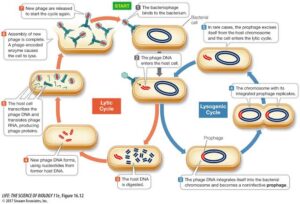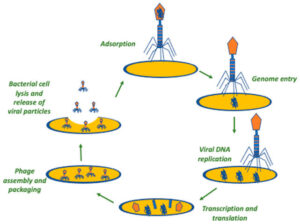Back to: MICROBIOLOGY 100 LEVEL
Welcome to class!
Hi superstar! Welcome back—it’s always a joy to learn with you. Today’s lesson is one that shows us how some viruses behave differently and how others cause diseases that affect people everywhere. Our focus is on Bacteriophages and Viral Diseases. Don’t worry, we’ll take it step by step in a simple and enjoyable way. Let’s begin!
Bacteriophages And Viral Diseases
Bacteriophages (Phages)
These are viruses that infect bacteria—yes, even bacteria can get sick too! The word “bacteriophage” means “bacteria eater”.
Structure of a Bacteriophage:
A typical bacteriophage has:
A head (capsid) containing genetic material (DNA or RNA)

A tail used to attach to the bacterial cell
Tail fibres to recognise and bind to specific bacteria
How Bacteriophages Work:
They follow the same lytic or lysogenic cycles we learned earlier:
In the lytic cycle, they hijack the bacterial cell to make more phages and then burst the cell open.
In the lysogenic cycle, they quietly insert their DNA into the bacterial DNA and remain dormant for a while.
Uses of Bacteriophages:
Phage Therapy: Used to treat bacterial infections, especially when antibiotics don’t work (like in drug-resistant infections).
Biotechnology: Phages are used in genetic research to study how DNA and genes work.
Food Industry: Used to kill harmful bacteria in food processing, especially in meat and dairy.
Viral Diseases in Humans
Some viruses attack humans and cause illness. These can range from mild fevers to serious life-threatening diseases.
Common Viral Diseases:
HIV/AIDS
Caused by the Human Immunodeficiency Virus (HIV)
Attacks the immune system, making the body weak against infections
Influenza (Flu)
Caused by the influenza virus
Symptoms include fever, cough, body pain
Hepatitis (A, B, C)
Affects the liver
Spread through contaminated food, water, blood or body fluids
COVID-19
Caused by the coronavirus (SARS-CoV-2)
Affects the lungs and causes symptoms like cough, fever, and difficulty breathing
Ebola
Caused by the Ebola virus
Severe and often deadly; causes bleeding and fever
Spread through contact with body fluids of infected people or animals
Prevention of Viral Diseases:
Vaccination is one of the best ways to protect yourself
Good hygiene, like handwashing and proper food handling

Avoid contact with infected individuals
Safe sex practices and use of clean needles
Think of bacteriophages as tiny police officers that only arrest bacteria. But some viruses are like robbers that break into human cells and cause trouble. Knowing their tricks helps us stay safe and find ways to fight back.
Summary
- Bacteriophages are viruses that infect bacteria and can be helpful in medicine and food safety.
- They have a head, tail, and tail fibres, and use the lytic or lysogenic cycle to reproduce.
- Viral diseases like HIV, flu, hepatitis, COVID-19, and Ebola affect humans and can be very serious.
- Prevention through vaccines, hygiene, and healthy practices is very important.
Evaluation
- What is a bacteriophage?
- Name one way bacteriophages are useful to humans.
- Give two examples of viral diseases that affect the liver and the immune system.
- How can we protect ourselves from viral diseases?
- What cycle do phages use to destroy bacterial cells?
Knowing how viruses behave helps us protect ourselves and use science to our advantage. Keep learning with Afrilearn—you’re doing great things, and the future is yours!
